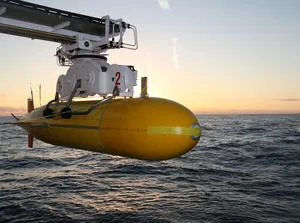
Developments in the use of autonomous underwater vehicles for science and industry are the subject of an international conference which takes place in Southampton next month (September 2012) – the first time the event has been held in the United Kingdom.
IEEE AUV 2012 is a collaborative event dedicated to autonomous underwater vehicles (AUVs) for ocean applications. It is organised by the Oceanic Engineering Society, which is governed by the Institute of Electrical and Electronics Engineers (IEEE), and co-sponsored by the Society for Underwater Technology. Seven leading companies are Patrons for the event. The conference will be hosted at the Southampton waterfront campus of the UK’s National Oceanography Centre (NOC) from 25 to 27 September.
AUVs – a term covering gliders and propeller-driven submersibles, such as the NOC-developed family of Autosubs - are playing an increasingly important role in helping scientists and industry understand the oceans. All can be programmed, some can be deployed for long periods, some to depths of 6,000 metres, most gather data about the water column, measuring ocean currents, while an increasing number map or photograph the ocean floor, reaching places inaccessible to other machines – such as the undersides of glaciers.
Under a heading of Persistent Presence, IEEE AUV 2012 will explore the challenges of deploying AUVs for longer periods, improving sensor capacity and making the machines less dependent on human intervention after deployment. Demands for greater capability by users means that AUV developers are focused on making improvements in areas such as energy efficiency, propulsion, command and control, payloads, and reliability.
The tutorial element of IEEE AUV 2012, taking place on day three, will focus on risk management, 3D data visualisation on the web and a hands-on demonstration of a software suite for AUVs. A poster session and award for best student paper will also feature in the programme.
The National Oceanography Centre is a fitting venue for the conference. Earlier this year, the UK’s Marine Autonomous & Robotic Systems (MARS) facility, which provides glider and AUV technology and expertise for the wider UK marine science community, on behalf of the Natural Environment Research Council, went live at the centre.
NOC’s Chief Technologist, Professor Gwyn Griffiths, is Head of MARS and is also conference chair for IEEE AUV 2012. He said “The IEEE AUV 2012 conference will bring together some of the world’s leading developers of AUV technology for what is sure to be a stimulating and rewarding exchange of ideas and expertise. Making autonomous underwater vehicles a more ‘persistent presence’ in the world’s oceans, helping us do more and better research, is a key ambition for those working in this field.“
The main AUV2012 conference will take place on 25 and 26 September and tutorials will take place on 27 September.